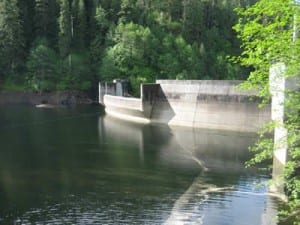
With drought conditions continuing in southern Southeast Alaska, Ketchikan Public Utilities is encouraging energy conservation. At a Ketchikan Chamber of Commerce luncheon earlier this month, KPU representatives spoke about the current energy situation and simple ways to save energy and lower bills.
Normally, 98 percent of Ketchikan’s energy comes from hydropower. That’s according to Jeremy Bynum, an engineer with KPU Electric. He says of that, more than half comes from Southeast Alaska Power Agency projects, and the rest from KPU-owned facilities. He says because of the ongoing drought, diesel generators are currently providing about half of Ketchikan’s power.
Bynum says the city receives climate updates from the National Oceanic and Atmospheric Administration, and NOAA notes the Ketchikan area is in a severe drought that has lasted more than six months.
“That means that we are receiving lower than normal inflows. Last year we received about 100 inches of precipitation. Ketchikan over the past 120 years has seen, on average, about 150 inches of precipitation. Some years more, some years less.”
Looking ahead to the summer, Bynum says the weather service predicts above average temperatures.

“That’s not necessarily a bad thing. Sometimes warm weather can bring rain. Our prediction for the next three months is that we have about a 50 to 60 percent probability that we’re going to be drier than normal. This isn’t absolute, but all we can do is take the information that’s being provided to us and have an idea about where we’re going to be.”
Bynum believes this summer will be similar to last summer, with drier conditions and warmer temperatures.
“So what it means for our (electric) generation is that we can expect that our hydro assets in Ketchikan and our partners at SEAPA will be constrained with their ability to meet our needs.”
Bynum encourages conservation and says simple changes can make a big difference. He says turning off a space heater, lowering a water heater to 120 degrees Fahrenheit, and turning out a few lights can reduce energy use by 5 to 10 percent.
“And if all of our businesses and our community members participated in that activity through this period of time, over the next three to four months, it can have a dramatic effect on our ability to continue to deliver as much hydropower as possible with as little diesel-augmented power as possible. And that would dramatically lower everyone’s effective rate.”
Kim Simpson is the sales, marketing and business division manager of KPU Telecommunications. She gave examples of how KPU Telecom is conserving. Simpson says last summer, KPU Telecom’s energy use was up. They discovered the air conditioning was on too high and employees were turning on space heaters to stay warm. Simpson says once they adjusted the air conditioning, energy use went down significantly. She says LED lighting was installed which reduced consumption by more than 15 percent.
“What we’ve done now, is we’ve turned off half of our lights, so we only have half the banks of lights on. We’ve turned off the big TVs that we have running in the mall. We make sure that employees have their computers powered off at the end of the day. So from an average of 2,735 (kwh), we went down to 1,963.”
Simpson says KPU has reached out to other businesses with suggestions on how to save. As an example, she says the school district had been powering up all computers at the beginning of the day, but now is having employees power up their own computers when they come in. Simpson says the school district also is turning off lights if classrooms have enough exterior light coming in. She says the recreation center has also made changes.
“So there are businesses that made conservation efforts already, but we’re hoping that everybody will make an effort, not just in their business, but even in their own home.”
Simpson says making sure appliances and heaters are functioning properly can save energy. She says a customer complained about a high electric bill. Simpson says they suggested it might be due to a faulty water heater.
“She kept saying, ‘But you don’t understand. I don’t have hot water. It’s always lukewarm.’ Well, what is was, is the element was (broken). So it was continually trying to heat the water but it wasn’t heating the water, and that was a key tip for her, because her consumption kept going up and up. So if you’re suspicious about something or it seems odd, there may be something wrong with something in your home.”
Bynum was asked whether KPU is looking at developing other forms of energy or additional hydropower projects. He says development of a hydropower facility is very costly and takes up to 30 years to permit.
“For this immediate crisis that we have, which I’ll refer to as a ‘crisis,’ this drought, we don’t know that it’s going to be persistent and last for many, many years to come. So for us to try to make decisions that are going to be very expensive and time consuming, we just don’t know that there’s an economic case to be doing that yet.”
Bynum says KPU and SEAPA are having discussions on future energy needs. For now, he and Simpson encourage everyone to help conserve while the drought continues.
Kim Simpson serves on KRBD’s Board of Directors.





